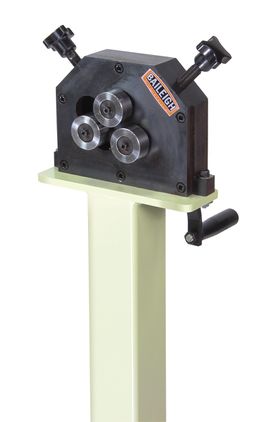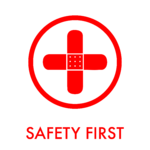Difference between revisions of "Ring Roller"
| Line 35: | Line 35: | ||
Here are some safety instructions for the {{PAGENAME}}. Remember... SAFETY FIRST!!! | Here are some safety instructions for the {{PAGENAME}}. Remember... SAFETY FIRST!!! | ||
* Always be aware of the position of the clamp handle and the counterweight. They are heavy and can swing back suddenly causing serious body or head injuries. | * Always be aware of the position of the clamp handle and the counterweight. They are heavy and can swing back suddenly causing serious body or head injuries. | ||
| − | * | + | * Keep hands and fingers away from the rolls when the machine is in operation. |
| − | * | + | * Keep hands and fingers clear of any gears or mechanisms. Make sure guard is in place before operating machine. |
| − | * | + | * Keep hands and fingers from between the roller and die when bending materials to avoid possible injury. |
| − | |||
| − | |||
==Description== | ==Description== | ||
Revision as of 10:11, 18 May 2022
Make: Baileigh Industrial
Model: R-M5
Serial Number: US14464115
Ace: Luke Roderick (lroderick20@georgefox.edu).
Location: Machine Shop
Safety First
Here are some safety instructions for the Ring Roller. Remember... SAFETY FIRST!!!
- Always be aware of the position of the clamp handle and the counterweight. They are heavy and can swing back suddenly causing serious body or head injuries.
- Keep hands and fingers away from the rolls when the machine is in operation.
- Keep hands and fingers clear of any gears or mechanisms. Make sure guard is in place before operating machine.
- Keep hands and fingers from between the roller and die when bending materials to avoid possible injury.
Description
A ring roller is a machine used to roll metal into a ring by forcing the material through rollers, also called dies. The rollers can be adjusted to change the formed radius. The maximum mild steel machine capacity is 1/4" x 1" flat bar or 1/2" round rod. The minimum diameter you can form is 2.75"
Here is an example of this piece of equipment being used.
Documentation
Terminology
- Dies - Round pieces of steel used to guide the material as its shaped.
Training
Operation
Insert Text
Demonstration
Demonstrate you can safely setup the Ring Roller. You will then proceed to cut a 5" long piece of 1/4" steel rod. Roll this material into the smallest radius possible. When rolling the material remember to keep your fingers away from the rollers to keep from smashing your fingers.
General Procedure
- Adjust the knob on the right to adjust the radius, loosen the handle on the left if it restricting you from adjusting the right one.
- Make sure both knobs are secure and tightened before rolling, always start by rolling the largest radius, and work your way up from there.
- Insert the bar between the rollers.
- Turn the crank to roll the metal bar or rod.
- Start with a large radius and continue to make the radius smaller every time you roll. If you attempt to roll a small radius all at once, the rod may make a corkscrew shape instead of a circle.
- You have completed the roll when the two ends overlap each other by a couple of inches to account for the ends of the bar or rod that stay straight.
Certification
[ https://georgefox.instructure.com/courses/1319 Canvas Quiz]
Troubleshooting
Maintenance
General maintenance
Insert text
Specific Maintenance Tasks
| Maintenance Procedure | Frequency | Done By |
|---|---|---|
| Sample | Sample | Sample |

